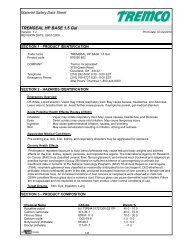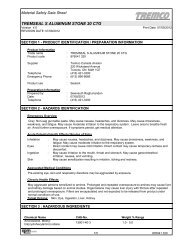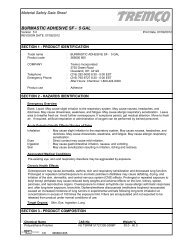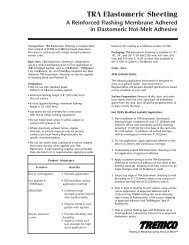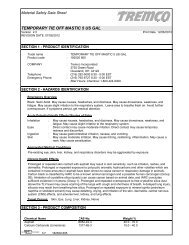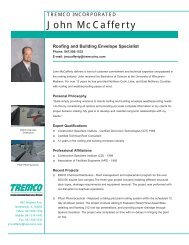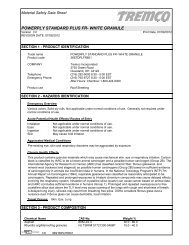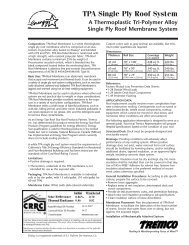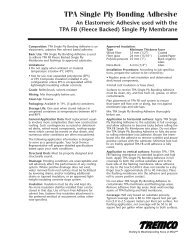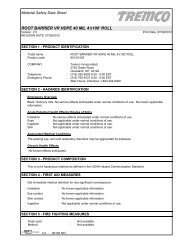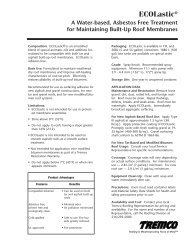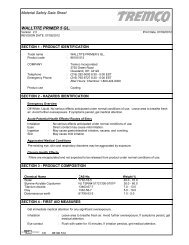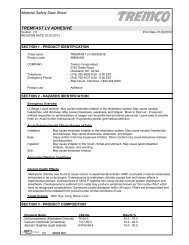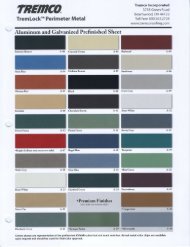SHEETING BOND A.F.-U.S. 5 US GL - Tremco Roofing
SHEETING BOND A.F.-U.S. 5 US GL - Tremco Roofing
SHEETING BOND A.F.-U.S. 5 US GL - Tremco Roofing
You also want an ePaper? Increase the reach of your titles
YUMPU automatically turns print PDFs into web optimized ePapers that Google loves.
Material Safety Data Sheet<br />
<strong>SHEETING</strong> <strong>BOND</strong> A.F.-U.S. 5 <strong>US</strong> <strong>GL</strong><br />
Version 4.0 Print Date 07/08/2012<br />
REVISION DATE: 07/07/2012<br />
SECTION 1 - PRODUCT IDENTIFICATION / PREPARATION INFORMATION<br />
Product Information<br />
Trade name : <strong>SHEETING</strong> <strong>BOND</strong> A.F.-U.S. 5 <strong>US</strong> <strong>GL</strong><br />
Product code : 361581 805<br />
Supplier : <strong>Tremco</strong> Canada division<br />
220 Wicksteed Avenue<br />
Toronto, ON M4H 1G7<br />
Telephone : (416) 421-3300<br />
Emergency Phone: : (613) 996-6666<br />
Preparation Information<br />
Prepared by: : Sewnauth Raghunandan<br />
Date: : 07/07/2012<br />
Telephone : (416) 421-3300<br />
SECTION 2 - HAZARDS IDENTIFICATION<br />
Emergency Overview<br />
Black. Paste. May cause nausea, headaches, and dizziness. May cause drowsiness, weakness, and fatigue.<br />
May cause slight irritation to the respiratory system. Leave area to breathe fresh air. Avoid further<br />
overexposure. If symptoms persist, get medical attention.<br />
Acute Potential Health Effects/ Routes of Entry<br />
Inhalation : May cause nausea, headaches, and dizziness. May cause drowsiness, weakness, and<br />
fatigue. May cause slight irritation to the respiratory system.<br />
Eyes : Direct contact may cause moderate irritation. Direct contact may cause temporary<br />
redness and discomfort.<br />
Ingestion : May cause gastrointestinal irritation, nausea, and vomiting.<br />
Skin : May cause moderate irritation. May cause itching, reddening, inflammation. May cause a<br />
rash. May cause sensitization.<br />
Aggravated Medical Conditions<br />
Pre-existing eye, skin, liver, kidney, and respiratory disorders may be aggravated by exposure.<br />
Chronic Health Effects<br />
Prolonged or repeated skin contact with asphalt may result in skin sensitivity, such as irritation, rashes, and<br />
dermatitis. Prolonged or repeated exposure to polycyclic aromatic hydrocarbons and other volatiles which are<br />
contained in trace amounts in asphalt have been shown to cause cancer or respiratory damage in animals.<br />
Prolonged or repeated exposure to xylene may cause defatting, drying, and irritation of the skin, dermatitis,<br />
central nervous system (CNS) effects, heart muscle sensitization and arrhythmia, hearing loss, and brain, liver,<br />
kidney damage. Xylene overexposure may affect fetal development. Carbon black is classified by IARC to be a<br />
known animal carcinogen and a possible human carcinogen (Group 2B). Carbon black is encapsulated by resin<br />
and not expected to have adverse effects unless made airborne. The International Agency for Research on<br />
Cancer (IARC) has evaluated ethylbenzene and classified it as a possible human carcinogen (Group 2B) based<br />
on sufficient evidence for carcinogenicity in experimental animals, but inadequate evidence for cancer in<br />
exposed humans. Fillers are encapsulated and not expected to be released from product under normal<br />
conditions of use.<br />
Target Organs: Skin, Eye, Lung, Liver, Kidney, Nerve<br />
1/6 361581 805
Material Safety Data Sheet<br />
<strong>SHEETING</strong> <strong>BOND</strong> A.F.-U.S. 5 <strong>US</strong> <strong>GL</strong><br />
Version 4.0 Print Date 07/08/2012<br />
REVISION DATE: 07/07/2012<br />
SECTION 3 : HAZARDO<strong>US</strong> INGREDIENTS<br />
Chemical Name CAS-No. Weight % Range<br />
Xylene 1330-20-7 15.0 - 40.0<br />
Carbon Black 1333-86-4 15.0 - 40.0<br />
Asphalt 8052-42-4 10.0 - 30.0<br />
Ethylbenzene 100-41-4 3.0 - 7.0<br />
The ingredients listed above are hazardous as defined in the controlled products regulation. (CPR).<br />
SECTION 4 - FIRST AID MEASURES<br />
Get immediate medical attention for any significant overexposure.<br />
Inhalation : Leave area to breathe fresh air. Avoid further overexposure. If symptoms persist, get<br />
medical attention.<br />
Eye contact : Flush with water for at least 15 minutes while holding eye lids apart. Get medical<br />
attention immediately.<br />
Skin contact : Clean area of contact thoroughly using soap and water. If irritation, rash or other<br />
disorders develop, get medical attention immediately.<br />
Ingestion : Do not induce vomiting unless advised by a physician. Call nearest Poison Control<br />
Center or Physician immediately.<br />
SECTION 5: FIRE / EXPLOSION HAZARDS<br />
Flash point : Not available.<br />
Method : Not available.<br />
Burning rate : Non-flammable solid<br />
Lower explosion limit : Not available.<br />
Upper explosion limit : Not available.<br />
Autoignition temperature : Not available.<br />
Extinguishing media : If water fog is ineffective, use carbon dioxide, dry chemical or foam.<br />
Hazardous combustion<br />
products<br />
Protective equipment for<br />
firefighters<br />
: Smoke, fumes.Carbon monoxide and carbon dioxide can form.Oxides of<br />
sulfur can form.<br />
: Use accepted fire fighting techniques. Wear full firefighting protective<br />
clothing, including self-contained breathing apparatus (SCBA).<br />
Fire and explosion conditions : Product may ignite if heated in excess of its flash point.Vapors may<br />
travel to sources of ignition and flashback.Vapor concentrations in<br />
enclosed areas may ignite explosively.Empty containers may contain<br />
ignitable vapors.<br />
SECTION 6 - SPILLS / LEAKS / ACCIDENTAL RELEASE MEASURES<br />
Use appropriate protective equipment. Avoid contact with material. Remove sources of ignition immediately.<br />
Stop flow of material if safe to do so. Contain spill and keep out of water courses. Ventilate area.<br />
2/6 361581 805
Material Safety Data Sheet<br />
<strong>SHEETING</strong> <strong>BOND</strong> A.F.-U.S. 5 <strong>US</strong> <strong>GL</strong><br />
Version 4.0 Print Date 07/08/2012<br />
REVISION DATE: 07/07/2012<br />
SECTION 7 - HANDLING AND STORAGE<br />
Prevent inhalation of vapor, ingestion, and contact with skin eyes and clothing. Keep container closed when<br />
not in use. Precautions also apply to emptied containers. Do not smoke, weld, generate sparks, or use flame<br />
near container. Do not use in confined or poorly ventilated areas. Personal protective equipment must be worn<br />
during maintenance or repair of contaminated mixer, reactor, or other equipment. Store under dry warehouse<br />
conditions away from heat and all ignition sources.<br />
SECTION 8 - PREVENTIVE MEASURES/EXPOSURE CONTROLS/PERSONAL PROTECTION<br />
Personal protection equipment<br />
Respiratory protection : Wear appropriate, properly fitted NIOSH/MSHA approved organic vapor or<br />
supplied air respirator when airborne contaminant level(s) are expected to<br />
exceed exposure limits indicated on the MSDS. Follow manufacturer's<br />
directions for respirator use.<br />
Hand protection : Use suitable impervious nitrile or neoprene gloves and protective apparel to<br />
reduce exposure.<br />
Eye protection : Wear appropriate eye protection.Wear chemical safety goggles and/or face<br />
shield to prevent eye contact. Do not wear contact lenses. Do not touch eyes<br />
with contaminated body parts or materials. Have eye washing facilities readily<br />
available.<br />
Skin and body protection : Prevent contact with shoes and clothing.<br />
Protective measures : Use professional judgment in the selection, care, and use.Inspect and replace<br />
equipment at regular intervals.<br />
Engineering measures : Use only in well ventilated areas. Provide maximum ventilation in enclosed<br />
areas.Use local exhaust when the general ventilation is inadequate.<br />
Exposure Limits<br />
Chemical Name CAS Number Regulation Limit Form<br />
Xylene 1330-20-7 Ontario TWAEV: 435 mg/m3<br />
Ontario STEV: 650 mg/m3<br />
ACGIH TWA: 100 ppm<br />
ACGIH STEL: 150 ppm<br />
Carbon Black 1333-86-4 Ontario TWAEV: 3.5 mg/m3<br />
ACGIH TWA: 3.5 mg/m3<br />
Asphalt 8052-42-4 ACGIH TWA: 0.5 mg/m3 Inhalable fraction.as<br />
benzene solubles<br />
Ontario TWAEV: 0.5 mg/m3 Inhalable fume.as<br />
benzene solubles<br />
Ethylbenzene 100-41-4 Ontario TWAEV: 435 mg/m3<br />
Ontario STEV: 540 mg/m3<br />
ACGIH TWA: 100 ppm<br />
ACGIH STEL: 125 ppm<br />
3/6 361581 805
Material Safety Data Sheet<br />
<strong>SHEETING</strong> <strong>BOND</strong> A.F.-U.S. 5 <strong>US</strong> <strong>GL</strong><br />
Version 4.0 Print Date 07/08/2012<br />
REVISION DATE: 07/07/2012<br />
SECTION 9 - PHYSICAL AND CHEMICAL PROPERTIES<br />
Physical State : Paste<br />
Form : Paste<br />
Color : Black<br />
Odor : Aromatic<br />
pH : Not available.<br />
Vapour pressure : Not available.<br />
Vapor density : Heavier than air<br />
Melting point/range : Not available.<br />
Freezing point : Not available.<br />
Boiling point/range : Not available.<br />
Water solubility : Negligible<br />
Evaporation Rate: : Not available.<br />
Specific Gravity : 1.065<br />
% Volatile Weight : 25 %<br />
SECTION 10 - REACTIVITY / STABILITY<br />
Substances to avoid : Oxidizing agents.<br />
Stability : Material is stable under normal storage, handling, and use.<br />
Hazardous polymerization : Will not occur under normal conditions.<br />
SECTION 11 - TOXICOLOGICAL INFORMATION<br />
Xylene, CAS-No.: 1330-20-7<br />
Acute oral toxicity (LD-50 oral) 4,300 mg/kg ( Rat ) 1,590 mg/kg ( Mouse ) 6,670 mg/kg (<br />
Rat ) 3,523 - 8,600 mg/kg ( Rat ) 5,627 mg/kg ( Mouse )<br />
Acute inhalation toxicity (LC-50) 6,350 mg/l for 4 h ( Rat ) 3,907 mg/l for 6 h ( Mouse ) 8,000<br />
mg/l for 4 h ( Rat )<br />
Ethylbenzene, CAS-No.: 100-41-4<br />
Acute oral toxicity (LD-50 oral) 5,460 mg/kg ( Rat ) 3,500 mg/kg ( Rat )<br />
Acute dermal toxicity (LD-50 dermal) 17,800 mg/kg ( Rabbit )<br />
SECTION 12 - ECOLOGICAL INFORMATION<br />
No Data Available<br />
SECTION 13 - WASTE DISPOSAL CONSIDERATIONS<br />
Disposal Method : Dispose as hazardous waste according to all local, state, federal and provincial<br />
4/6 361581 805
Material Safety Data Sheet<br />
<strong>SHEETING</strong> <strong>BOND</strong> A.F.-U.S. 5 <strong>US</strong> <strong>GL</strong><br />
Version 4.0 Print Date 07/08/2012<br />
REVISION DATE: 07/07/2012<br />
regulations.<br />
SECTION 14 - TRANSPORTATION / SHIPPING DATA<br />
TDG:<br />
Not Regulated<br />
CFR / DOT:<br />
IMDG:<br />
Not Regulated<br />
Not Regulated<br />
SECTION 15 - REGULATORY INFORMATION<br />
North American Inventories:<br />
All components are listed or exempt from the TSCA inventory.<br />
This product or its components are listed on, or exempt from the Canadian Domestic Substances List.<br />
Canadian Regulations:<br />
WHMIS Classification : D2A, D2B<br />
This is a "controlled product" under the Canadian Workplace Hazardous Materials Information System<br />
(WHMIS).<br />
This product has been classified in accordance with the hazard criteria of the Controlled Products Regulations<br />
(CPR) and the MSDS contains all of the information required by the CPR.<br />
Other Regulations:<br />
Regulatory VOC (less water and<br />
exempt solvent)<br />
SECTION 16 - OTHER INFORMATION<br />
HMIS Rating :<br />
: 273 g/l<br />
Health 2 0 = Minimum<br />
Flammability 2<br />
Reactivity 0<br />
PPE<br />
Further information:<br />
1 = Slight<br />
2 = Moderate<br />
3 = Serious<br />
4 = Severe<br />
For Industrial Use Only. Keep out of Reach of Children. The hazard information herein is offered solely for the<br />
consideration of the user, subject to their own investigation of compliance with applicable regulations, including<br />
the safe use of the product under every foreseeable condition.<br />
5/6 361581 805
Material Safety Data Sheet<br />
<strong>SHEETING</strong> <strong>BOND</strong> A.F.-U.S. 5 <strong>US</strong> <strong>GL</strong><br />
Version 4.0 Print Date 07/08/2012<br />
REVISION DATE: 07/07/2012<br />
Prepared by: Sewnauth Raghunandan<br />
Legend<br />
ACGIH - American Conference of Governmental Hygienists OSHA - Occupational Safety and Health Administration<br />
DOT - Department of Transportation PEL - Permissible Exposure Limit<br />
DSL - Domestic Substance List RCRA - Resource Conservation and Recovery Act<br />
EPA - Environmental Protection Agency STEL - Short Term Exposure Limit<br />
HMIS - Hazardous Materials Information System TLV - Threshold Limit Value<br />
IARC - International Agency for Research on Cancer TSCA - Toxic Substances Control Act<br />
MSHA - Mine Safety Health Administration TWA - Time Weighted Average<br />
NDSL - Non-Domestic Substance List V - Volume<br />
NIOSH - National Institute for Occupational Safety and Health VOC - Volatile Organic Compound<br />
NTP - National Toxicology Program WHMIS - Workplace Hazardous Materials Information System<br />
6/6 361581 805



